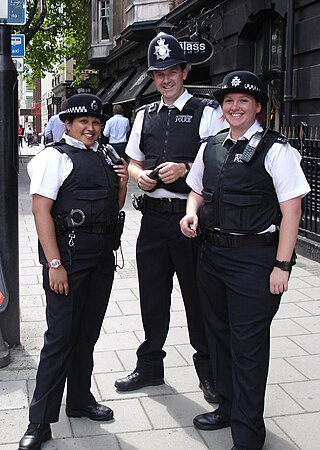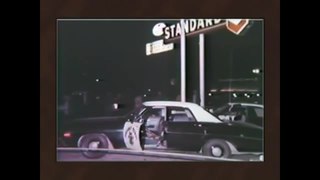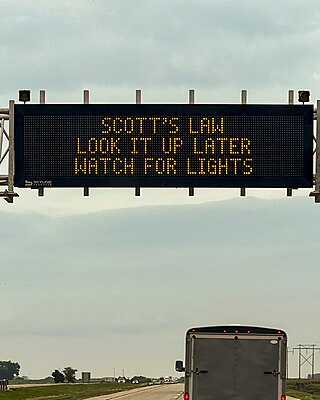
A line of duty death (LODD) is a death in the fire service or the police service while on duty.

A line of duty death (LODD) is a death in the fire service or the police service while on duty.
The National Fire Protection Association (NFPA) report has tracked on-duty firefighter deaths in the United States since 1977. The average annual number of on-duty firefighter deaths from 2014 to 2018 was 65. However, in 2019, there were 48 on-duty firefighter deaths in the United States, a sharp drop and the first year that the annual total was under 50 deaths. Of the 48 on-duty deaths in 2019, 20 were career firefighters and 25 were volunteer firefighters, one was a civilian Defense Department employee, one was a state land management employee, and one was a federal land management agency employee. [1]
Sudden cardiac death has consistently constituted the largest share of on-duty firefighter deaths. [1] Of 2019 on-duty firefighter deaths in the U.S., 54% were due to medical emergencies, overexertion, or stress (included in this category were 22 heart attacks or other sudden cardiac deaths, 2 strokes, 1 heatstroke, and 1 suicide); 13% by fire progress (such as being trapped or overrun) or explosions, 8% were struck by a vehicle, 8% died in vehicle crashes, 6% fell from heights (such as buildings, fire apparatus, roofs, and bridges), and 10% died from other causes. [1] In 2019, of on-duty firefighter deaths, 27% died at fire sites (10 structure fires, 3 wildland fires), 19% died during non-fire emergencies, 19% died while responding to or returning from alarms, 10% died in training, and 25% died in other on-duty settings (such as performing ordinary fire station, administrative, or maintenance duties). [1]
An analysis of FBI data published in 2019 in the Criminology & Public Policy found that police line-of-duty deaths in the United States fell 75% between 1970 and 2016. [2] The number of deaths from aircraft crashes and accidental gunfire declined over time, but deaths in car chases were stable, and deaths from vehicular assaults doubled. [2]
According to data compiled by the National Law Enforcement Officers Memorial, over the period 2010 to 2019, there were 1,627 U.S. police officer line-of-duty deaths, including 528 deaths by gunfire, 459 deaths from job-related illness, 335 deaths from automobile crashes, 130 from being struck by a vehicle, 58 in motorcycle crashes, 25 by drowning, 20 by beatings, 19 in falls, 13 in aircraft accidents, 5 by strangulation, 4 by being struck by train, 3 by electrocution, 2 in horse-related accidents, and 1 in a terrorist attack. [3] Deaths in motor vehicle crashes or motor vehicle strikes represented about 43% of all police line-of-duty deaths over the period 2006 through 2019 (about 809 deaths); these are preventable injuries. [4]
In 2019, 48 law enforcement officers died in line-of-duty injuries from "felonious incidents" while 41 died in accidents. [5] [6] Of the 48 deaths in felonious incidents, 15 were connected to "investigative/enforcement activities" (including traffic stops, investigations, and encounters with fugitives); 9 deaths were connected to "tactical situations" (such as barricade/hostage situations or service of search or arrest warrants); 5 officers died in unprovoked attacks; 4 officers died while responding to reports of crimes in progress; 3 officers died while in a car pursuits; 3 officers died while trying to make an arrest. [5] Of the 41 accidental deaths, 19 died in motor vehicle crashes, 16 were pedestrians struck by vehicles; 3 died in "firearm-related incidents"; and 2 officers drowned. [6]
More than 90% of homicides of U.S. law enforcement officers are caused by gunshot. [7] For example, in 2019, 44 of the 49 officers feloniously killed were killed by firearms. [5] A 2015 study published in the American Journal of Public Health , analyzing FBI data from 1996 to 2010, studied the link between firearm prevalence (measured by the mean household firearm ownership) and homicides of police officers using a Poisson regression. The study concluded that, when controlling for other variables, law enforcement homicide rates "were 3 times higher in states with high firearm ownership compared with states with low firearm ownership." [7]
A 2018 white paper, commissioned by the Ruderman Family Foundation, found that U.S. police officers and U.S. firefighters were more likely to die by suicide than in the line of duty. Both police and firefighters have considerably higher rates of suicide when compared to the population at large. Citing prior studies, the white paper connected elevated suicide rates among police and firefighters to "critical incidents" (traumatic events) experienced in the line of duty, leading to higher rates of post-traumatic stress and depression. The white paper called for de-stigmatization of mental health concerns among first responders (stating that "shame and stigma are arguably the strongest barriers that stand between first responders and mental health services") and more suicide prevention initiatives for first responders. [8]
Police line-of-duty deaths are far less common in Britain than in the United States. From 1900 to 2014, 249 British police officers died in the line of duty; adjusting for number of police officers, U.S. police line-of-duty deaths are 10 times higher than British police line-of-duty deaths. [9]
A comparison of police deaths in New York City and Greater London from 1900 through 1999 found that "both intentional and unintentional occupational police mortality rates were significantly greater in New York compared to London"; the study officers identified "socioeconomic, cultural, and occupational factors" (including the widespread prevalence of firearms in the U.S.) as the likely factors explaining the discrepancy. [10]

A police officer is a warranted law employee of a police force. In most countries, "police officer" is a generic term not specifying a particular rank. In some, the use of the rank "officer" is legally reserved for military personnel.
Suicide by cop, also known as suicide by police or law-enforcement-assisted suicide, is a suicide method in which a suicidal individual deliberately behaves in a threatening manner, with intent to provoke a lethal response from a public safety or law enforcement officer to end their own life.

Cumbria Constabulary is the territorial police force in England covering the unitary authority areas of Cumberland and Westmorland and Furness in the ceremonial county of Cumbria. As of September 2017, the force had 1,108 police officers, 535 police staff, 93 police community support officers, and 86 special constables.

The Metropolitan Police Department of the District of Columbia (MPDC), more commonly known as the Metropolitan Police Department (MPD), the DC Police, and, colloquially, the DCPD, is the primary law enforcement agency for the District of Columbia, in the United States. With approximately 3,400 officers and 600 civilian staff, it is the sixth-largest municipal police department in the United States. The department serves an area of 68 square miles (180 km2) and a population of over 700,000 people. Established on August 6, 1861, the MPD is one of the oldest police departments in the United States. The MPD headquarters is at the Henry J. Daly Building, located on Indiana Avenue in Judiciary Square across the street from the District of Columbia Court of Appeals and the Superior Court of the District of Columbia. The department's mission is to "safeguard the District of Columbia and protect its residents and visitors with the highest regard for the sanctity of human life". The MPD's regulations are compiled in title 5, chapter 1 of the District of Columbia Code.

The Port Authority of New York and New Jersey Police Department, or Port Authority Police Department (PAPD), is a law enforcement agency in New York and New Jersey, the duties of which are to protect and to enforce state and city laws at all the facilities, owned or operated by the Port Authority of New York and New Jersey (PANYNJ), the bi-state agency running airports, seaports, and many bridges and tunnels within the Port of New York and New Jersey. Additionally, the PAPD is responsible for other PANYNJ properties including three bus terminals, the World Trade Center in Lower Manhattan, and the PATH train system. The PAPD is the largest transit-related police force in the United States.

Austin Police Department (APD) is the principal law enforcement agency serving Austin, Texas. As of Fiscal Year 2022, the agency had an annual budget of $443.1 million and employed around 2,484 personnel, including approximately 1,809 officers. The department also employs 24 K-9 police dogs and 16 horses. As of 2023, Robin Henderson is the current Interim Chief of Police.

As of 2020, more than 800,000 sworn law enforcement officers have been serving in the United States. About 137,000 of those officers work for federal law enforcement agencies.

Gun-related violence is violence committed with the use of a firearm. Gun-related violence may or may not be considered criminal. Criminal violence includes homicide, assault with a deadly weapon, and suicide, or attempted suicide, depending on jurisdiction. Non-criminal violence includes accidental or unintentional injury and death. Also generally included in gun violence statistics are military or para-military activities.

The Newhall incident, also called the Newhall massacre, was a shootout on April 5–6, 1970, in Valencia, California, between two heavily armed criminals and four officers of the California Highway Patrol (CHP). In less than five minutes, the four CHP officers were killed and another man was pistol-whipped in the deadliest day in California law enforcement history.

Below are lists of people killed by law enforcement in the United States, both on duty and off duty. Although Congress instructed the Attorney General in 1994 to compile and publish annual statistics on police use of excessive force, this was never carried out, and the Federal Bureau of Investigation does not collect these data.

The use of firearms by police forces varies widely across the world, in part due to differences in gun use policy, civilian firearm laws, and recording of police activity. Police forces may require that officers use warning shots before aiming on-target, officers may need to make verbal warnings before using their firearms, and officers may be prohibited from carrying weapons while performing tasks such as highway patrol where gun use is not expected.
There are numerous issues affecting the safety and health of police officers, including line of duty deaths and occupational stress.
In the United States, use of deadly force by police has been a high-profile and contentious issue. In 2022, 1,096 people were killed by police shootings according to The Washington Post, while according to the "Mapping Police Violence" (MPV) project, 1,176 people were killed by police in total. MPV documented 1,213 killings by police for 2023.

Scott's Law, 625 ILCS 5/11-907(c), is a mandatory move over law in the state of Illinois. The law requires that all motorists move over when encountering stopped or disabled emergency vehicles displaying warning lights. The law is used to prosecute a failure to give ample care to stopped vehicles, including not reducing speed, changing lanes, or using caution, and can be a compounding offense on roadway incidents with such a vehicle.

Jeffrey L. Smith, a Washington, D.C. Metropolitan Police officer, shot himself on January 15, 2021, after he assisted the United States Capitol Police on January 6, during the response to the storming of the Capitol. A psychiatrist hired by Officer Smith's widow found that drastic changes in Smith's behavior after January 6 are evidence that the attack on the Capitol was the precipitating event leading to his suicide. On October 13, 2021, two United States Senators and several members of the House of Representatives called for the Mayor to award Line of Duty benefits to Officer Smith and his widow Erin Smith. On March 7, 2022, Officer Smith's death was officially ruled line of duty by the District of Columbia. After petition by his widow, DC Police and Firefighters' Retirement and Relief Board found that the "direct and sole" cause of Officer Smith's death were the injuries he received in the line of duty while responding to the Capitol riot on January 6, 2021.
On February 18, 2024, during a police standoff in Burnsville, Minnesota, United States, Shannon Gooden shot and killed police officers Paul Elmstrand and Matthew Ruge and firefighter-paramedic Adam Finseth. Another police officer was injured by gunfire. After firing at the first responders, Gooden died by a suicide—a single, self-inflicted gunshot wound to the head. The officers were responding to a 911 call that reported an alleged sexual assault.